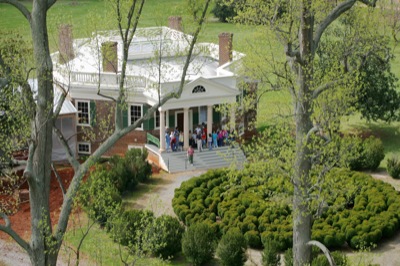
James Madison, the Father of the Constitution, was raised at the Montpelier estate in the foothills of the Blue Ridge Mountains near Orange, Virginia; lived there after his marriage to the vivacious Dolley Payne Todd; returned to Montpelier after serving as the fourth president of the United States; and died there in his book-lined study.
The house underwent extensive changes and additions over the years, but an exhaustive five-year project that concluded in 2008 returned Madison’s beloved house to the way it looked when he and Dolley lived there.
“We feel the house is really something James and Dolley would recognize,” said Beth Morrill, media manager for Montpelier.
An extensive detective project is now under way to uncover and return Montpelier’s original furnishings, which a financially strapped Dolley had to sell after her husband’s death.
“It is a constantly evolving process,” said Morrill.
Another ongoing restoration of a former house of a Founding Father is under way at Thomas Jefferson’s Poplar Forest retreat near Forest, Virginia.
Although Jefferson lived most of his life in the more famous Monticello, near Charlottesville, Virginia, Poplar Forest was his refuge.
“Poplar Forest was his retreat,” said Anna Bentson, director of public relations and marketing for Poplar Forest. “He built it while he was president, directing the construction from the White House. He started coming here in 1809, after he left the presidency.”
Montpelier and Poplar Forest are two of many sites in the South that are associated with America’s chief executives. Fourteen of the 43 men who have served as president of the United States were born in the South, and other, non-Southern presidents found relief from the pressures of their jobs in Southern retreats.
Thus, there is an abundance of places for groups to find a connection to a former president, from lovingly preserved birth sites to final resting places, from secluded retreats to sprawling estates.
Montpelier
Orange, Virginia
After Dolley Madison sold Montpelier, it went through several hands before being purchased by the duPont family, who owned it for most of the 20th century before leaving it to the National Trust for Historic Preservation.
“A lot of changes were made,” said Morrill. “It had doubled in size and had a pink stucco covering. It looked very different. It had changed inside also. Our guides were finding it difficult to tell the story of James and Dolley when they walked into a drawing room but it was not their drawing room.
“We began to very carefully deconstruct the parts that were not original,” said Morrill. The wings added by the duPonts were demolished, and the stucco finish was removed to expose the original brick.
“After 2008 began the presidential detective story,” said Morrill. “She [Dolley] had to sell Montpelier and all its furnishings, and we are in the process of bringing those furnishings back. There have been a lot of exciting finds.”
Some pieces are being placed in the house, but other items belonging to the Madisons are displayed in a gallery at the visitors center, including James’ spyglass and snuffbox and Dolley’s engagement ring.
www.montpelier.org
540-672-2728
Poplar Forest
Forest, Virginia
Bentson said guided tours of Poplar Forest provide a different perspective of Jefferson.
“The focus of the tour is Jefferson’s time here,” she said. “It’s a different Jefferson story than you get in other places, not so much the statesman and president, but what he did in his spare time.”
Jefferson spent much of the time writing and reading.
“It is a very private place, meant for one person,” said Bentson.
The unusual octagon-shaped house has been open to the public during the restoration, which has been ongoing for the past 20 years. “You can see the craftsmen at work and ask them questions,” Bentson said.
The house is only minimally furnished. “It is more of an architectural exhibit,” she said. “It’s a different approach from a typical house museum.
“Although the middle and right side will ultimately be completed, we are leaving one or two rooms in various stages of restoration so you can see, for example, how the craftsmen found ghost marks on the wall to know where the alcove bed was.”
www.poplarforest.org
434-525-1806
Roosevelt’s Little White House
Warm Springs, Georgia
Another president who sought refuge in the South was Franklin D. Roosevelt, who began going to Warm Springs, Georgia, in the 1920s seeking a cure in the area’s warm waters for the polio that had struck him.
Although Roosevelt found no cure, he did get relief swimming in the waters and built a small house there in 1932 while governor of New York. After becoming president the following year, Roosevelt returned on many occasions to what became known as the Little White House, where he worked on many landmark pieces of New Deal legislation at a card table in the living room.
On April 12, 1945, FDR died in the house. “He was sitting for a portrait and suffered a cerebral brain hemorrhage,” said Robin Glass, manager of the Little White House site, part of the Georgia state parks system. “He was carried to the bedroom, where he passed away.
“The Little White House is like it was the day he died. We haven’t changed it in any way. It has all the original furniture and beds. You walk right through it.”
A nearby museum building has artifacts and personal mementos of Roosevelt’s life, including the 1938 Ford convertible with hand controls he helped design.
“He would drive when he was here,” said Glass.
About a mile away is the historic pool complex where Roosevelt swam. “There is a little museum that tells the story of polio and displays different things used in its treatment, like an iron lung,” said Glass.
Glass said the 235,000-gallon pool is filled twice a year, for the Saturday through Monday of Memorial Day and Labor Day weekends.
“You can actually swim in that water,” he said. “It is very, very popular. There are 80 people at a time for 90-minute sessions.”
http://georgiastateparks.org/
littlewhitehouse
706-655-5870
Harry Truman
Little White House
Key West, Florida
Harry S. Truman found relief from his job at another Southern Little White House at a naval base in Key West, and like Roosevelt, he also continued to conduct business from the house, which was originally built in 1890 as the base commander’s home.
“It was not just a vacation retreat but a functioning White House,” said Bob Wolz, director of the Harry Truman Little White House.
The house, which combines elements of late Victorian and West Indian architecture, has been restored to Truman’s time there, with 90 percent of the original furnishings.
“It’s not palatial by any means, but it is higher end,” he said.
“An acre of botanical gardens are around us. While the trees were here in Truman’s time, many of the shrubs were not. We replanted to appear as in 1949.”
Wolz said guided tours of the house focus more on Truman than the furnishings. “It is not a furniture tour,” he said. “The most important thing is, one person can change the world. Things out of his administration truly changed the way America thinks and operates.”
www.trumanlittlewhitehouse.com
305-294-9911
Jimmy Carter National
Historic Site
Plains, Georgia
“You never know when you might see President Carter,” said Steve Theus, interpretative ranger at the Jimmy Carter National Historic Site in Plains. “He could be riding his bike around town or walking. He still teaches Sunday school when he is in town.”
Three sites in the small town of some 700 residents tell the story of Jimmy Carter’s rise from an isolated Depression-era Georgia peanut farm without electricity to the highest office in the land.
“We primarily deal with his early life on up to when he ran for president,” said Theus.
The 1921 building that housed the Plains High School is now a visitors center and museum.
“President and Mrs. Carter both graduated from Plains High School,” said Theus.
One room has been restored to reflect a 1937 classroom with old-fashioned desks with black cast-iron frames lined up in front of a blackboard. Three other rooms have exhibits about Carter: his early life up to when he left for the Navy, the time he spent back in Plains before being elected president and the work of his Carter Center since he left the presidency.
The 1888 train depot that was Carter’s 1976 presidential campaign headquarters has exhibits about the campaign.
Carter’s boyhood farm, about three miles from town, has been restored to 1937, the year before electricity was installed.
Theus said that with advance notice, the park service will provide a step-on guide for motorcoach groups. “We will greet the bus and take it around Plains and out to the farm, where we can do a peanut boil, or blacksmithing or other demonstrations,” he said.
The Carters still maintain their home in Plains. In lieu of having visitors to their home, the Carters produced a video of the interior of their house, which is shown at the visitors center.
www.nps.gov/jjca
229-824-4104
Southeast Tourism Society Tour Planner:
Welcome back to Southeast
A solemn Civil War sesquicentennial
Southeast gardens
Southeast cuisine









